Ledebouria caesiomontana
Ledebouria caesiomontana Hankey & N.Hahn
Family: Asphodelaceae
Common names: Blouberg African hyacinth
Introduction
This small and cryptic species remains very elusive in its natural habitat, due to its ability to hide amongst grasses and other vegetation, as a result it is seldom seen. The species was only named in 2014, and is known from very few records.
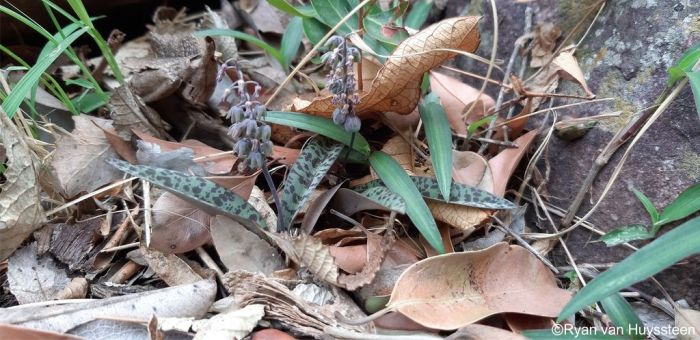
Description
Description
Dwarf bulbous plants, occurring mostly as solitary individuals or in small groups of a few plants growing together. The small whitish bulb is approx. 25 mm long and 15 mm wide, often tightly wedged between rock crevices and usually hidden amongst grass. The 3 to 5 oblanceolate leaves, up to 100 mm long and 15 mm wide, are produced in summer; they are dull green with darker green to purple brown spots above, with few, scattered, longitudinal rows of broken and unbroken, papillate ridges, usually more towards the margins. The undersides of the leaves are usually plain green to suffused with red and may also be banded towards the narrowed leaf base.
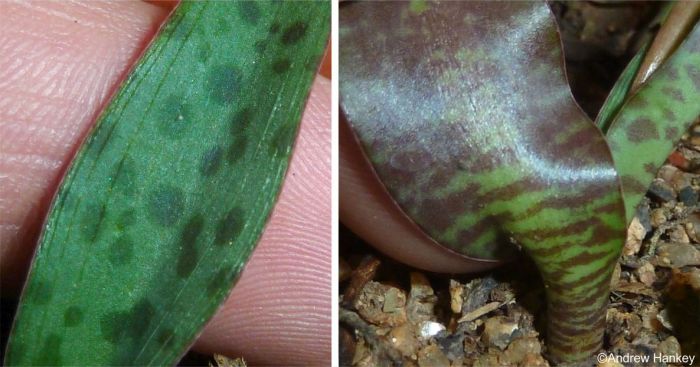
During the summer flowering season (October to December), each bulb produces a usually solitary, elongated inflorescence, which can be up to 120 mm long, and hangs outward from the bulb, with the apex usually curved upward. Small individual flowers (florets) are clustered towards the tip of the flower spike, each small flower is comprised of 6 greenish tepals (petals), which typically have pinkish margins and a pinkish pedicel (floret stalk). The pedicels are cernous (curved), giving the unopened buds a nodding appearance. The violet coloured anthers extend from the cup of the floret and are topped with yellow pollen. The seeds are tiny, wrinkled and dark brown to almost black.

Conservation Status
Status
Ledebouria caesiomontana has not been assessed for the Red List of South African plants, however the original description of the species (Hankey et.al. 2014), proposed that a category of Vulnerable (VU), be assigned, due to ongoing habitat loss in the areas where the species occurs.
Distribution and habitat
Distribution description
Ledebouria caesiomontana occurs in moist forest and forest margins as well as closed woodland, where it is often found amongst rocks and grasses. The species was originally thought to be endemic only to the Blouberg, a mountain range in Limpopo Province, however, unverified reports of the species also occurring on the adjacent Soutpansberg have subsequently been reported.
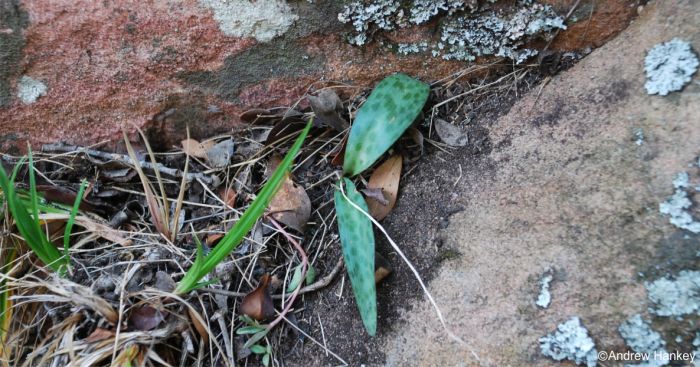
Derivation of name and historical aspects
History
This species was first described by the author and Dr Norbert Hahn in 2014, after conducting a joint field expedition in 2007 to the Blouberg in search of this species, which had been recorded there before. The specific name is made up of two Latin words, viz. caesio-, meaning ‘blue’, and –montana, meaning ‘mountain’, it was named in reference to the Blouberg (Blue Mountain) from which the species was first known.
The genus is named in honour of the German-Estonian botanist, Professor Carl Friedrich von Ledebour (1785–1851). South Africa has 58 species of Ledebouria, with several more species occurring across southern, western, eastern and northeastern Africa and into India.
The genus Ledebouria is a member of the Hyacinth Family and is represented across South Africa with 61 species currently recognized. This species is most closely related to L. papillata, from which it differs by the longer and more numerous oblanceolate leaves, as well as the longer inflorescences which are not held erect as in L. papillata.
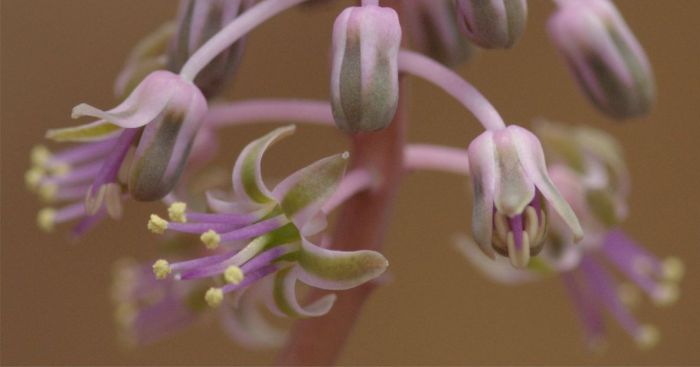
Ecology
Ecology
As with most plants in this genus, the flowers are open and somewhat cup-shaped, presenting the pollen to most bee-sized insect pollinators, and are thus opportunistically pollinated by any visiting insects. After pollination the seed capsules develop rapidly and the small seeds are released by the bursting and shriveling seed capsule. Venter (1993) noted during his research that seed is spread by sheet water wash after thunderstorms and rain.
Uses
Use
There is no record of this species being utilized locally by humans, there is also very little known about the ecology of the species.
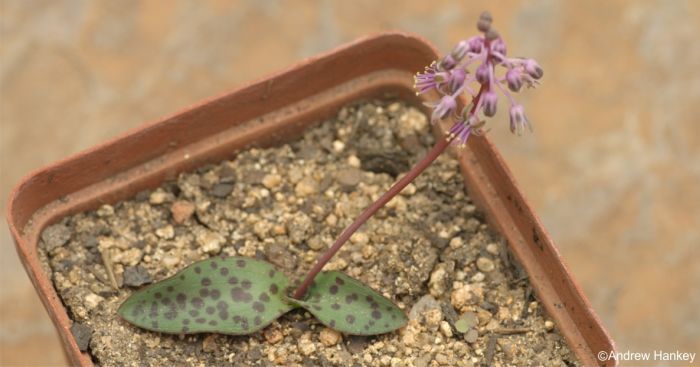
Growing Ledebouria caesiomontana
Grow
Although this species is exceedingly rare in cultivation, it is easy to cultivate and should ideally be maintained in pots because of its small size. The bulbs prefer a humic-rich, loamy potting soil, with sand added to improve drainage. They can be kept in semi-shade to full sun and only watered between rain showers during the summer growing season. During the dormant period in winter the pots should be allowed to dry out with only an occasional light surface watering to maintain soil humidity. The emergence of the leaves usually coincides with the increased soil temperatures in spring, at which time watering can recommence.
Propagation of this species is most successful from fresh seed sown in summer. Seed can be sown directly into pots or trays filled with the sifted growing mixture, pressed lightly and covered with a thin layer (2 mm) of fine sand or the same sifted potting mix. Germination is quick and can occur between 3 to 6 weeks. Seedlings can be left in their natal containers for up to three years or until they become too congested and then should be planted out in small clusters or as individuals into pots. Seedlings are susceptible to mealy bug below soil level, which can be treated using a systemic insecticide; damping off can occur during early establishment of the seedlings and precautions should be implemented in the form of a systemic fungicide.
References
- Hankey, A.J. 2019. Proposed English common names for African hyacinths (genus Ledebouria). Plantlife SA, Vol 47:7 https://plantlifesouthafrica.blogspot.com/
- Hankey, A.J., Hahn, N. & Buys, M.H. 2014. Ledebouria caesiomontana A.J.Hankey & N.Hahn (Hyacinthaceae: Hyacinthoideae): A new species from the Blouberg centre of endemism, Limpopo, South Africa. Bothalia 44(1), Art. 119, 4 pages.
- iNaturalist. Observation of Ledebouria caesiomontana by Ryan van Huyssteen on 5 Dec 2019. https://www.inaturalist.org/observations/46367843.
- Venter, S. 1993. A revision of the genus Ledebouria Roth (Hyacinthaceae) in South Africa. Unpublished M.Sc. thesis, University of Natal, Pietermaritzburg.
- Venter, S. 2008. Synopsis of the genus Ledebouria Roth (Hyacinthaceae) in South Africa. Herbertia 62
- Wikipedia. Carl Friedrich von Ledebour. http://en.wikipedia.org/wiki/Carl_Friedrich_von_Ledebour. Accessed 6 November 2018.
Credits
Andrew Hankey
Walter Sisulu National Botanical Garden
August 2021
Acknowledgements: Ryan van Huyssteen is acknowledged for the image of Ledebouria caesiomontana growing in the Soutpansberg, all other images by the author.
Plant Attributes:
Plant Type: Bulb
SA Distribution: Limpopo
Soil type: Loam
Flowering season: Spring, Early Summer
PH: Neutral
Flower colour: Green, Pink
Aspect: Full Sun, Morning Sun (Semi Shade), Afternoon Sun (Semi Shade)
Gardening skill: Easy
Special Features:
Horticultural zones
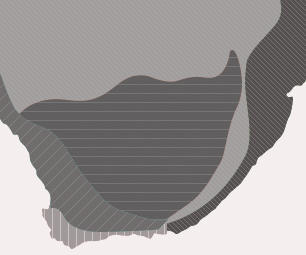








Rate this article
Article well written and informative
Rate this plant
Is this an interesting plant?
Login to add your Comment
Back to topNot registered yet? Click here to register.